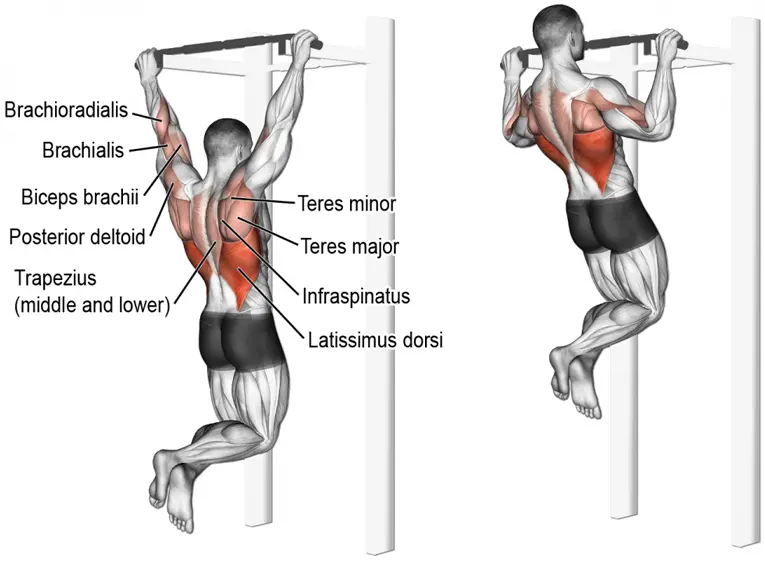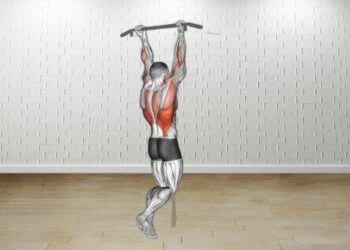Doing your first pull-up or chin-up is a real fitness milestone. A lot of exercisers dream about being able to do these demanding bodyweight exercises, and some never achieve this goal. But, with perseverance and patience, most people should be able to master this back-building move.
That said, as good as pull-ups and chin-ups are, they’re not always possible or practical. If you are a “big guy,” you may simply be too heavy to lift your body weight with just your arms. There may also be times when you have nowhere suitable to do pull-ups.
Also, while pull-ups and chin-ups are undeniably good exercises, if that’s all you ever do, you’ll soon find yourself in a workout rut. For some people, these exercises can be a source of elbow pain too.
The good news is that there are plenty of alternatives you can use in place of these exercises. They work the same muscles and involve different training equipment.
So, can’t do pull-ups or chin-ups? No problem! Just use one of these pull-up alternative exercises instead!
Pull-Up and Chin-Up – The Basics
Firstly, pull-ups and chin-ups are similar but different exercises. The main difference is the position of your hands. In pull-ups, you use a pronated or overhand grip, usually with your hands slightly wider than shoulder-width apart. Some people do pull-ups with a wider grip than this too.
Level Up Your Fitness: Join our 💪 strong community in Fitness Volt Newsletter. Get daily inspiration, expert-backed workouts, nutrition tips, the latest in strength sports, and the support you need to reach your goals. Subscribe for free!
In contrast, chin-ups are done with a supinated or underhand grip. The hands are usually less than shoulder-width apart for this variation. Chin-ups can also be done with a parallel or neutral grip.
Both pull-ups and chin-ups affect the same muscles (1), namely:
- Latissimus dorsi – lats for short, this is the muscle on the side of your upper back. The lats are responsible for shoulder extension and adduction. When well-developed, the lats look like wings and are visible from the front and the back.
- Biceps brachii – usually just known as the biceps, this is the muscle on the front of your upper arm. Its main role in pull-ups and chin-ups is the flexion of your elbow. For many people, pull-ups and chin-ups are as much a biceps exercise as a lats exercise.
- Middle and lower trapezius and rhomboids – these muscles are located between and across your upper back. In pull-ups and chin-ups, they contract to hold your scapulae or shoulder blades down and back.
- Forearms – several muscles make up your forearms, and they’re all involved in pull-ups and chin-ups. After all, you need to grip the bar to support your weight. A lot of exercisers use wrist straps to reinforce their grip, especially when doing the weighted version of these exercises.
For an in-depth discussion about the differences and benefits of pull-ups vs. chin-ups, check out this article.
Before we reveal the best alternatives to pull-ups and chin-ups, let’s discuss what makes these exercises so popular and effective.
Minimal equipment required – unlike a lot of muscle and strength-building exercises, you don’t need a lot of equipment to do pull-ups or chin-ups. All you really need is a bar to hang from. No bar? No worries; you can also use a tree branch, a jungle gym at the park, or even the top of a door.
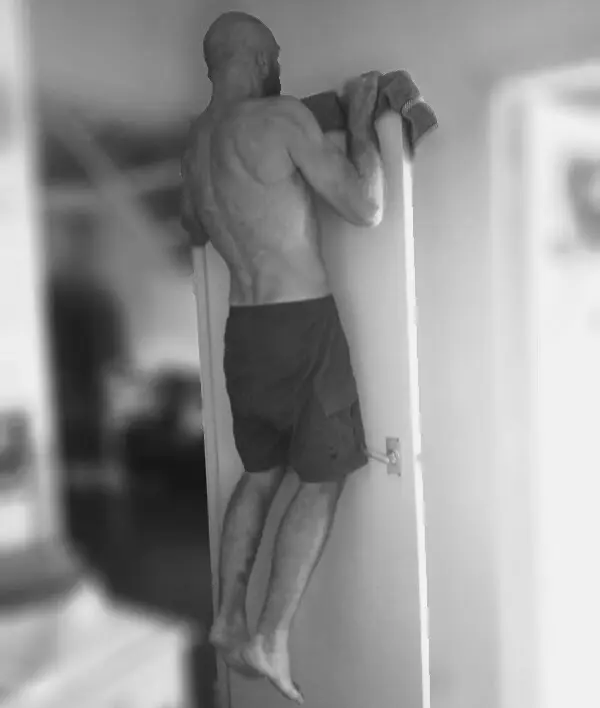
A time-efficient exercise – pull-ups and chin-ups are compound exercises, which means they use several joints and lots of muscles at the same time. In simple terms, these exercises use all of your major pulling muscles. If you are in a hurry and want to work your back, biceps, and several other important muscles at the same time, pull-ups and chin-ups allow you to get a lot of work done in a short time.
A good indicator of leanness/healthy body weight – if you can’t do many or any pull-ups or chin-ups, you may be overweight. You’ll also find that, if you lose weight, your performance of these exercises will improve. One way to get better at pull-ups and chin-ups, or any bodyweight exercise for that matter, is to lose weight.
They can be used to achieve multiple fitness goals – you can use pull-ups and chin-ups to build muscle, get stronger, and even increase muscle power. It all depends on how you load and perform them. To build muscle, do 6-12 reps, reaching muscular failure at the end of your set. To build strength, do 1-5 reps and rest 2-3 minutes between sets. For power, do your reps explosively, and consider progressing to muscle-ups.
They’re easy to regress and progress – despite being a bodyweight exercise, you can still regress and progress pull-ups and chin-ups according to your current fitness and strength. Make them easier by doing band pull-ups, leg-assisted pull-ups, or using an assisted pull-up/chin-up machine. Alternatively, you can make these exercises harder by using a weight belt or weighted vest. Beginner, intermediate, and advanced exercisers can all enjoy the benefits of pull-ups and chin-ups.
They’re badass exercises – grabbing an overhead bar and cranking out a set of pull-ups looks impressive. It’s not something that everyone can do. Strap on some extra weight for even more kudos. This goes double if you are a woman. If you want to turn heads in the gym, doing pull-ups and chin-ups will help!

The 10 Best Chin-up and Pull-up Alternatives
1. Lat pulldowns
Lat pulldowns use the same muscles as pull-ups and chin-ups, but instead of pulling yourself up to the bar, you pull the bar down to you. They’re also easier to scale than pull-ups and chin-ups. Plus, because most lat pulldown machines use selectorized weight stacks for resistance, they’re perfect for training systems like drop sets.
On the downside, doing lat pulldowns with more than your body weight can be tricky. For advanced exercisers, pull-ups and chin-ups are arguably a better choice.
https://fitnessvolt.com/24609/medium-grip-lat-pull-down/
2. Bent over rows
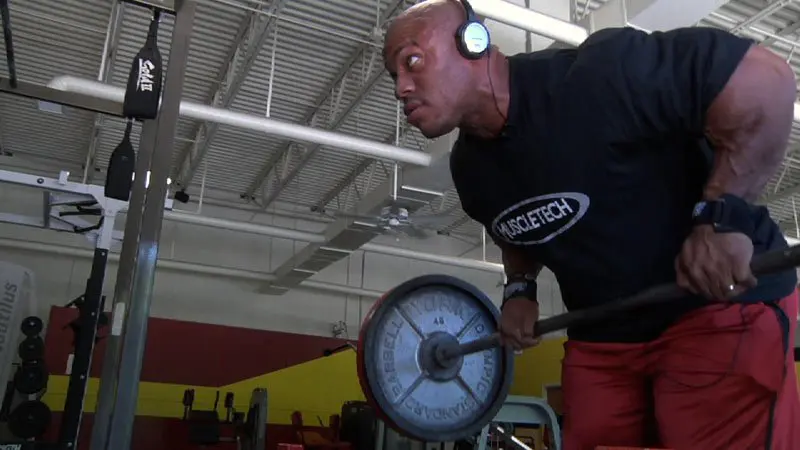
The main disadvantage of bent-over rows is the amount of stress they put on your lower back. This gets worse if you round your lower back instead of keeping a slightly curved or neutral spine. Avoid problems by always bracing your core, maintaining postural awareness, and wearing a weightlifting belt if you are lifting heavy.
Level Up Your Fitness: Join our 💪 strong community in Fitness Volt Newsletter. Get daily inspiration, expert-backed workouts, nutrition tips, the latest in strength sports, and the support you need to reach your goals. Subscribe for free!
3. Pendlay rows

This pull-up alternative is named after USA weightlifting and powerlifting coach Glenn Pendlay. It’s basically a dead-stop bent over row where the weight is allowed to touch down and rest on the floor between reps. This gives your lower back a short rest between reps, which may make it preferable to regular bent-over rows for some exercisers.
4. T-bar rows
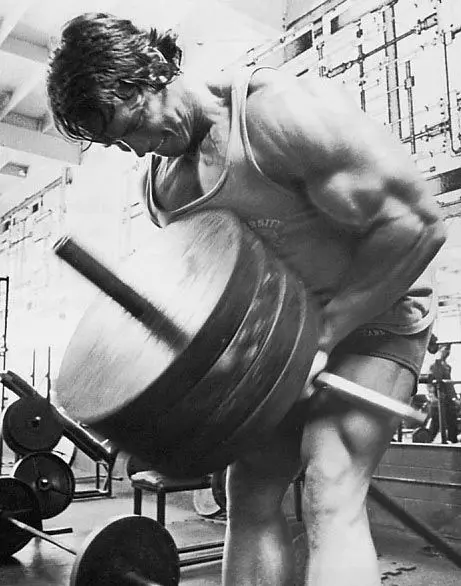
T-bar rows are an old-school favorite and was a staple of bodybuilding legend Arnold Schwarzenegger’s back training. To do it, you’ll need a T-bar row machine or, alternatively, you can just wedge one end of a barbell into a corner and stand astride it. Like bent-over rows, this exercise also works your lower back, glutes, and hamstrings, but because your body is a little more upright, it’s not as stressful on these areas.
5. Single-arm dumbbell rows
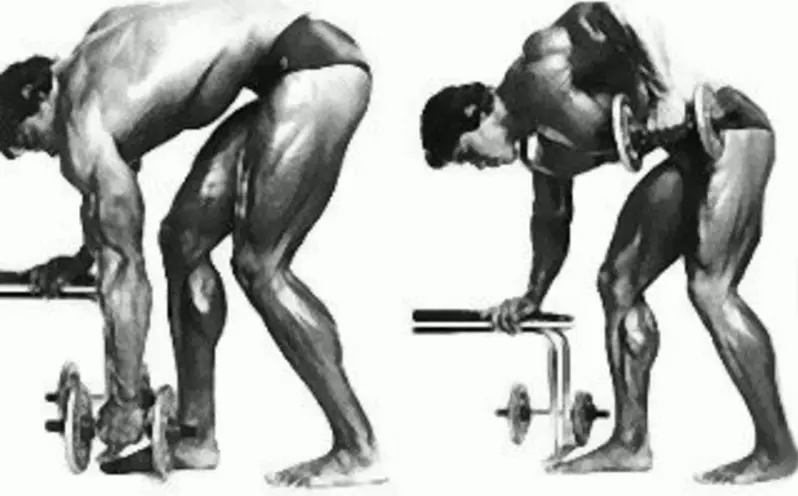
If barbell and T-bar rows have a disadvantage, it is that they’re hard on your lower back. That doesn’t mean you shouldn’t do them. After all, you need a strong lower back, and it would be a mistake to avoid training it.
But there is only so much work you can expect your lower back to do before fatigue increases your risk of injury. With this pull-up alternative, you have one arm free to provide your back with some added support. This leaves you free to focus on pumping out the reps.
Single-arm rows also provide you with an effective way to spot and fix any left-to-right strength or muscle size imbalances.
6. Renegade row
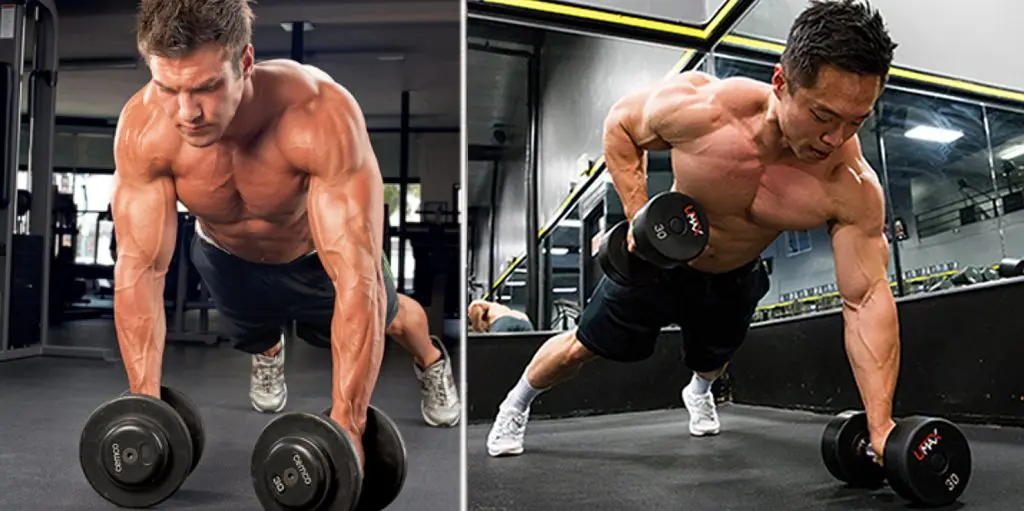
A lot of fitness trainers think that pull-ups and chin-ups are the most functional lat exercises you can do. While these exercises are definitely functional, renegade rows are very functional too.
This pull-up alternative is a tricky exercise that works not just your lats but your legs, core, and shoulders too. It’s a true full-body exercise. Go light with this exercise at first – it’s MUCH more challenging than it looks!
7. Inverted rows
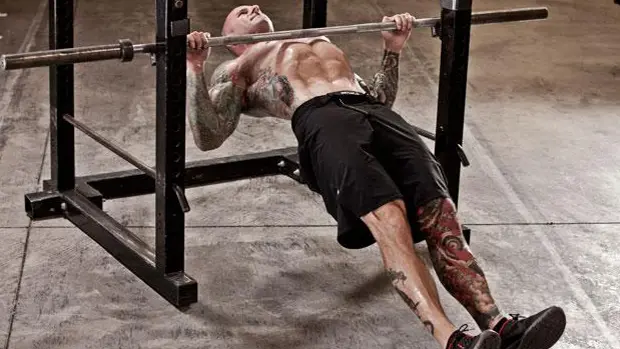
Inverted rows, also known as incline pull-ups and body rows, are a lot like pull-ups and chin-ups, except you do them with your feet on the floor. They’re a good gateway exercise to full pull-ups and chin-ups, as they work the same muscles while getting you used to using your body weight for resistance.
They can be done with an overhand or underhand grip and provide your middle trapezius, rhomboids, and posterior deltoids with a good workout. Do inverted rows using a Smith machine bar, a barbell in a squat/power rack, or a TRX suspension trainer.
8. Resistance band pulldowns
If you work out at home, you may not have access to anywhere to pull-ups, rows, or regular lat pulldowns. Does this mean you can’t work your lats? Absolutely not! All you need is a resistance band and a door. For home trainers, this exercise is a very useful pull-up alternative.
How to do it:
- Tie a knot in the center of your resistance band and then shut it in the top of a sturdy door. Take one end in each hand and then sit or kneel down.
- Bend your arms and pull your hands down to the front of your shoulders. Keep your abs braced, and your shoulders pulled down and back throughout.
- Extend your arms and repeat.
- You can also do this exercise by looping your band over a ceiling joist, tree branch, or using a doorway anchor made especially for resistance bands.
9. Resistance band rows
This pull-up alternative is another excellent move for home exercisers. It’s easy on your lower back, and all you need is a door, a resistance band, and somewhere to sit to work your back and biceps.
How to do it:
- Tie a knot in the middle of your resistance band and shut it in a door at about hip-height. Take an end in each hand and sit down, so your arms are extended at around shoulder-height.
- Bend your arms and pull your hands into your ribs. Keep your elbows close to your sides, and your shoulders pulled down and back.
- Extend your arms and repeat. Do not allow your lower back to round at any time.
- You can also do this exercise by standing on your band and adopting a bent-over row position. Increase band tension by moving your feet further apart. As with all rowing exercises, do not round your lower back!
10. Deadlifts

Our final pull-up alternative looks more like a leg exercise than a back exercise, but deadlifts are actually a suburb lat builder. During deadlifts, your lats must contract very hard to keep the bar close to your legs. If you don’t use your lats, the bar will drift forward, and you’ll probably end up shifting your weight from your heels to your toes. This will disengage your posterior chain, and you’ll likely fail your rep.
Deadlifts don’t directly involve your biceps, but apart from that, they’re a viable alternative for pull-ups and chin-ups.
Wrapping Up
Pull-ups and chin-ups are great exercises. They’re much loved by gymnasts, rock climbers, fighters, and the military. As bodyweight back-builders go, they’re very tough to beat. Most exercisers would benefit from doing more pull-ups and chin-ups!
But these exercises are also hard to learn and master, and they aren’t always possible. That’s especially true if you work out at home and don’t have access to a pull-up bar.
Thankfully, you can still work your lats and biceps without pull-ups or chin-ups. These 10 pull-up alternatives are every bit as effective, and you can use them to replace or supplement pull-ups and chin-ups in your back workouts.
Which one is best? That’s a good question. To be honest, there is no single best chin-up or pull-up alternative. Each one has benefits, as well as drawbacks. Try them all to see which one gives you the results you want!
References:
1 – PubMed: Surface electromyographic activation patterns and elbow joint motion during a pull-up, chin-up, or perfect-pullup™ rotational exercise https://pubmed.ncbi.nlm.nih.gov/21068680/
2 – PubMed: The effects of exercise variation in muscle thickness, maximal strength, and motivation in resistance-trained men https://www.ncbi.nlm.nih.gov/pmc/articles/PMC6934277/

